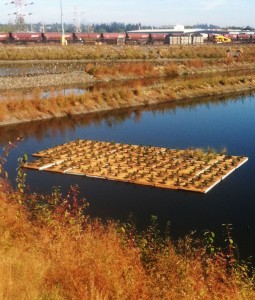Unique floating wetlands may help treat port’s stormwater
 After water quality tests indicated elevated levels of copper in stormwater runoff from the Port of Vancouver USA, port Environmental Manager Matt Graves and Environmental Specialist Phillip Martello started researching sustainable, cost-effective ways of reducing the amount of metals in the port’s Terminal 4 stormwater retention pond.
After water quality tests indicated elevated levels of copper in stormwater runoff from the Port of Vancouver USA, port Environmental Manager Matt Graves and Environmental Specialist Phillip Martello started researching sustainable, cost-effective ways of reducing the amount of metals in the port’s Terminal 4 stormwater retention pond.
Their research effort, with help from Kennedy Jenks Consultants, led them to a 2013 New Zealand study. The study concluded that manmade floating treatment wetlands (FTWs) could be the key to reducing metals such as copper and zinc, which can be harmful to fish in the Columbia River.
The idea is simple: FTWs use buoyant material to float on top of a body of water. Vegetation is planted on top so the roots grow into the water to attract and absorb sediments and metals suspended in the water. Larger, heavier sediments and metals sink to the bottom, which is how these ponds are designed. The New Zealand study, which is one of the only known research studies on this issue, shows this holistic approach can reduce the amount of copper by up to 55 percent.
Matt and Phil gathered information on FTW construction and found the wetlands can cost around $550,000 if built by a private vendor. Determined to find a more cost-effective solution, they put their heads together, developed their own blueprints, and researched materials and costs.
Using locally sourced foam insulation board and cedar boards, Matt and Phil built an “island” of common rush (Juncus effuses), a North American wetland plant.
They built their first FTW, which consists of 26 cells with 10 plantings apiece, and launched it into the Terminal 4 stormwater retention pond in late September.
It will take approximately two years for the plantings to establish so the port’s Environmental team can test their effectiveness. If tests show the FTW successfully reduces metals in the pond, Matt and Phil will build a total of 120 cells that will be anchored together and cover 20 percent of the stormwater pond’s surface area.
By constructing the cells themselves, Matt and Phil were able to save more than $520,000 and build the same product faster, making this project both cost- and resource-efficient.
The Port of Vancouver is proud to have employees who are dedicated to maintaining a healthy environment and saving funds!
